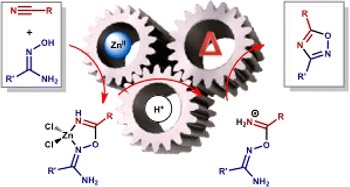D.S. Bolotin, K.I. Kulish, N.A. Bokach, G.L. Starova, V.V. Gurzhiy, V.Yu. Kukushkin
“Zinc(II)-Mediated Nitrile−Amidoxime Coupling Gives New Insights into H+‑Assisted Generation of 1,2,4-Oxadiazoles”
Inorg. Chem., 2014, 53, 10312-10324
DOI: 10.1021/ic501333s
The cyanamides Me2NCN (1a), OC4H8NCN (1b), and PhC(═O)N(H)CN (1c) and the conventional nitriles PhCN (1d) and EtCN (1e) react with 1 equiv of each of the amidoximes R′C(═NOH)NH2 (R′ = Me (2a), Ph (2b)) in the presence of 1 equiv of ZnCl2 producing the complexes [ZnCl2{HN═C(R)ON═C(R′)NH2}] (R/R′ = NMe2/Me (3a), NMe2/Ph (3b), NC4H8O/Me (3c), NC4H8O/Ph (3d), N(H)C(═O)Ph/Me (3e), N(H)C(═O)Ph/Ph (3f), Ph/Me (3g), Ph/Ph (3h), Et/Ph (3j)) with the chelate ligands originating from the previously unreported zinc(II)-mediated nitrile–amidoxime coupling. Addition of 1 equiv of p-TolSO3H to any of one 3a–h, 3j results in the ligand liberation and formation of the iminium salts [H2N═C(R)ON═C(R′)NH2](p-TolSO3) ([4a–j](p-TolSO3)), which then at 20–65 °C spontaneously transform to 1,2,4-oxadiazoles (5a–j). As a side reaction, cyanamide derived species [4a–f](p-TolSO3) undergo Tiemann rearrangement to produce the substituted ureas R′NHC(═O)NH2 (R′ = Me (6a), Ph (6b)) and RC(═O)NH2 (R = NMe2 (6c), NC4H8O (6d), N(H)C(═O)Ph (6e)), whereas phenyl and ethyl cyanide derivatives besides their transformation to the oxadiazoles undergo hydrolysis to the parent amidoxime R′C(═NOH)NH2 (R′ = Me (2a), Ph (2b)) and the carboxamides RC(═O)NH2 (R = Ph (6f), Et (6g)). All new obtained compounds were characterized by HRESI-MS, IR, ATR-FTIR, 1H NMR, CP-MAS TOSS 13C NMR, elemental analyses (C, H, N), and single crystal X-ray diffraction for seven species (3a–e, [4b](p-TolSO3), and [4d](p-TolSO3)). Two previously unknown heterocycles 5c and 5e were isolated and characterized by elemental analyses (C, H, N), HRESI-MS, IR, 1H and 13C{1H} NMR. The observed conversion of [4a–j](p-TolSO3) to the 1,2,4-oxadiazoles uncovers the mechanism of the previously reported H+-assisted generation of these heterocycles (Augustine; et al. J. Org. Chem. 2009, 74, 5640).
